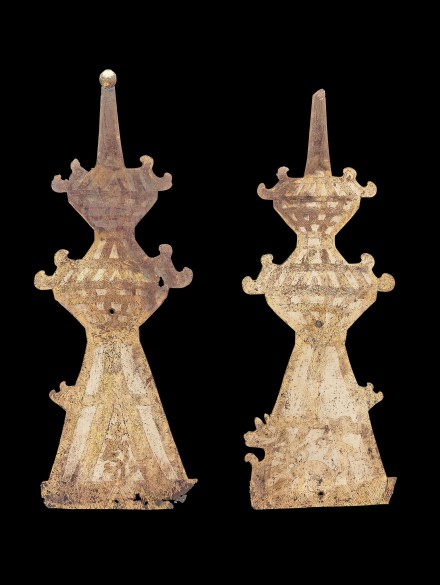J.J. Lally & Co., Oriental Art / New York City, New York
MenuPast Exhibition
Bronze and Gold in Ancient China
March 24 - April 12, 2003

27.
A PAIR OF GILT BRONZE TOWER-FORM PLAQUES (QUE)
Eastern Han Dynasty, A.D. 2nd - Early 3rd Century
together intended to symbolize the Gate of Heaven, each tower (que) shown in silhouette with tall splayed base supporting two storeys above a crossbeam engraved with a crested bird, each storey surmounted by a wide roof raised on dougong brackets, engraved with finely detailed concentric lozenge motif borders on the supporting beams and ridgepoles, the ends of each roof with scrolled elements and the top of each tower rising to a pinnacle, with a fantastic guardian lion-beast with wings sprouting from its shoulders shown tied to the base of one tower by a chain, the other tower with scroll motifs rising from the base, the decoration and outlines of the structural elements all engraved in dotted lines and highlighted with gilding on a silvered ground, pierced at the base and at the center to receive spikes for attachment, one tower with a circular boss from an attachment spike corroded in place on the top of the pinnacle, the surfaces unusually well preserved.
Heights 17 5⁄8 inches and 18 inches (44.8 cm and 45.7 cm)
Two similar engraved gilt bronze tower-form plaques in the Royal Ontario Museum, Toronto which were received as a donation from the Tanenbaum Collection are illustrated by Klaas Ruitenbeek in the exhibition catalogue entitled Chinese Shadows, Toronto 2002, cat. no. 14, p. 60.
27.
A PAIR OF GILT BRONZE TOWER-FORM PLAQUES (QUE)
Eastern Han Dynasty, A.D. 2nd - Early 3rd Century
Heights 17 5⁄8 inches and 18 inches (44.8 cm and 45.7 cm)